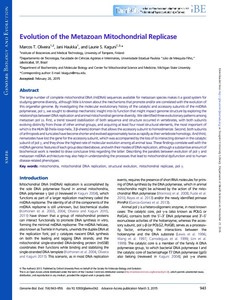Evolution of the metazoan mitochondrial replicase
Oliveira, Marcos T; Haukka, Jani; Kaguni, Laurie S (2015)
Oliveira, Marcos T
Haukka, Jani
Kaguni, Laurie S
2015
Genome Biology and Evolution 7 4
943-959
BioMediTech - BioMediTech
Julkaisun pysyvä osoite on
https://urn.fi/URN:NBN:fi:uta-201611172598
https://urn.fi/URN:NBN:fi:uta-201611172598
Tiivistelmä
The large number of complete mitochondrial DNA (mtDNA) sequences available for metazoan species makes it a good system for studying genome diversity, although little is known about the mechanisms that promote and/or are correlated with the evolution of this organellar genome. By investigating the molecular evolutionary history of the catalytic and accessory subunits of the mtDNA polymerase, pol γ, we sought to develop mechanistic insight into its function that might impact genome structure by exploring the relationships between DNA replication and animal mitochondrial genome diversity. We identified three evolutionary patterns among metazoan pol γs. First, a trend toward stabilization of both sequence and structure occurred in vertebrates, with both subunits evolving distinctly from those of other animal groups, and acquiring at least four novel structural elements, the most important of which is the HLH-3β (helix-loop-helix, 3 β-sheets) domain that allows the accessory subunit to homodimerize. Second, both subunits of arthropods and tunicates have become shorter and evolved approximately twice as rapidly as their vertebrate homologs. And third, nematodes have lost the gene for the accessory subunit, which was accompanied by the loss of its interacting domain in the catalytic subunit of pol γ, and they show the highest rate of molecular evolution among all animal taxa. These findings correlate well with the mtDNA genomic features of each group described above, and with their modes of DNA replication, although a substantive amount of biochemical work is needed to draw conclusive links regarding the latter. Describing the parallels between evolution of pol γ and metazoan mtDNA architecture may also help in understanding the processes that lead to mitochondrial dysfunction and to human disease-related phenotypes.
Kokoelmat
- Artikkelit [6140]
